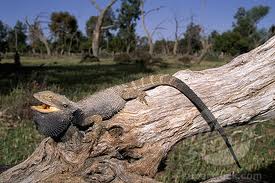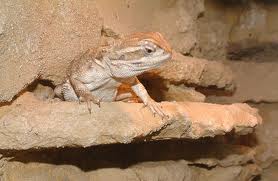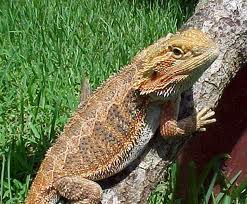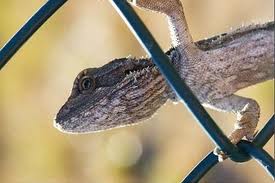Here are the known scientific name for your Bearded Dragons.
*Pogona barbata
*Pogona henrylawsoni
*Pogona microlepidota
*Pogona minor
*Pogona nullarbor
*Pogona vitticeps
*Pogona henrylawsoni
*Pogona microlepidota
*Pogona minor
*Pogona nullarbor
*Pogona vitticeps
(Pogona barbata)

The Eastern bearded dragon (Pogona barbata) is an agamid lizard found in wooded parts of Australia. It is one of a group of species known commonly as Bearded Dragons. Other common names for this species include Jew Lizard and Frilly Lizard, the latter being a confusion between this and another dragon; the Frilled Lizard (Chlamydosaurus kingii).
It is most common in eastern Australia south of Cape York Peninsula, but specimens have been collected from Cape York, through central Australia, and even from the west coast of Australia. It is a large species of grey-black colour distinguished from its relative, the central bearded dragon, Pogona vitticeps, by its less robust body and the row of spines along the lateral edge of the body, which continues over the forearm (Cogger, 1992). It tends to be more cryptic in its behaviour than the Central bearded dragon and performs its bearded display more often. It has an adult snout-tail length of about 24 inches (60 cm). When threatened, in addition to its beard display, it gapes to display the bright yellow colour of the inside of its mouth. They eat small lizards and snakes, flowers, insects, fruits, and berries.
This species was previously known as Amphibolurus barbatus.
It is most common in eastern Australia south of Cape York Peninsula, but specimens have been collected from Cape York, through central Australia, and even from the west coast of Australia. It is a large species of grey-black colour distinguished from its relative, the central bearded dragon, Pogona vitticeps, by its less robust body and the row of spines along the lateral edge of the body, which continues over the forearm (Cogger, 1992). It tends to be more cryptic in its behaviour than the Central bearded dragon and performs its bearded display more often. It has an adult snout-tail length of about 24 inches (60 cm). When threatened, in addition to its beard display, it gapes to display the bright yellow colour of the inside of its mouth. They eat small lizards and snakes, flowers, insects, fruits, and berries.
This species was previously known as Amphibolurus barbatus.
Physical description
The eastern bearded dragon resembles its close relative the smaller central bearded dragon. It is usually grey-black in skin colour and is sometimes reddish-brown, yellowish-brown, or dark brown. Juveniles are paler in colour than the adults and have patterns that fade as they mature. As it matures it develops a subtle pale yellow, blue, or green tinge on the forepart of its head. The adult males can grow up to about 24 inches (60 cm), and females up to 20 inches (50 cm). The adult males have a dark grey to black "beard".
P. barbata retains venom glands on both the upper and lower jaws.
P. barbata retains venom glands on both the upper and lower jaws.
Behavior
Eastern Bearded Dragons are diurnal. They are semi-arboreal and perch on exposed places such as tree branches or logs, retreating to lower and cooler places when too hot. The eastern bearded dragon is more aggressive than the central bearded dragon, demands more space and is less docile. The males are territorial and permit only females and juveniles in their territory. Dominant males are usually the biggest dragons and get the highest perch.
The eastern bearded dragon is also known to do the arm wave as a sign of submission or just for general communication.
When agitated or threatened, bearded dragons display their beard and gape.
The eastern bearded dragon is also known to do the arm wave as a sign of submission or just for general communication.
When agitated or threatened, bearded dragons display their beard and gape.
Diet
The eastern bearded dragon feeds on a variety of small vertebrates and invertebrates including crickets, small grasshoppers, worms, beetles, katydids, small mice, and small reptiles. In captivity they also eat a few vegetables. These include clover and dandelion flowers
(Pagona henrylawsoni)

Pogona henrylawsoni is an agamid lizard that is commonly known as Lawson's dragon. It is similar to the larger inland bearded dragon (Pogona vitticeps), but this dragon is usually less than 10 inches in length. This species is also called Rankin's Dragon, Dumpy Dragon, Dwarf Bearded Dragon, or the Black Soil Bearded Dragon.[2]
A formal description was not published for this dragon until 1985, despite being known to herpetologists. The name for this species was disputed, along with the other taxonomic treatments of Wells and Wellington, but was published again by Harold Cogger (2000) and others as a valid name.
The name is noted as invalid in some sources, and given as a synonym for Pogona brevis.
These dragons have a life span of 6–8 years, their natural environment is hot, dry and rocky, which must be mimicked in captivity. They are a social species and with supervision can be handled by children, but do not like to be turned upside down and will struggle when are. Most creatures in captivity are descendants of illegally imported dragons in the 1980s. The specific epithet is a reference to the Australian author Henry Lawson.
A formal description was not published for this dragon until 1985, despite being known to herpetologists. The name for this species was disputed, along with the other taxonomic treatments of Wells and Wellington, but was published again by Harold Cogger (2000) and others as a valid name.
The name is noted as invalid in some sources, and given as a synonym for Pogona brevis.
These dragons have a life span of 6–8 years, their natural environment is hot, dry and rocky, which must be mimicked in captivity. They are a social species and with supervision can be handled by children, but do not like to be turned upside down and will struggle when are. Most creatures in captivity are descendants of illegally imported dragons in the 1980s. The specific epithet is a reference to the Australian author Henry Lawson.
(Pogona microlepidota)

Also known as
Kimberley Bearded Dragon, Drysdale Bearded Dragon
Location
Small coastal region (Drysdale river) in north Kimberley, in north west Australia
Habitat
Coastal/ open woodland, bushes
Appearance
Less noticeable scales and spikes than other Pogona
Overall Adult Length
10-15cm / 4-6 inches
Diet
Mainly insects
Behaviour / Traits
Not much known, very rare

Pagona Minor
Pogona minor minor are large lizards, 38 cm in length (15 cm from snout to vent), P. minor minima is slightly smaller. All Bearded dragons have a chameleon-like colour, either blending into their environment or presenting a brighter display during interaction with others. It is similar in appearance to Pogona nullarbor and Caimanops amphiboluroides (Mulga Dragon), but is distinguished by a smaller head size, and the arrangement of spines on the underside and neck. The Western bearded dragon is widespread in Southwest Australia and central deserts, the range includes semiarid regions such as woodland or heathland, and arid desert or coastal dunes. This subspecies also occurs on Dirk Hartog Island. Pogona minor minima is found on West, North, and East Wallabi Islands, Houtman Abrolhos.
These dragons display a behaviour common to other Pogona species, the dragon will wave its hand to trigger a response from a potential predator. Another typical behaviour of is that of 'head-bobbing' amongst males, perhaps related to dominance within their social order. It is often seen basking on fence posts
These dragons display a behaviour common to other Pogona species, the dragon will wave its hand to trigger a response from a potential predator. Another typical behaviour of is that of 'head-bobbing' amongst males, perhaps related to dominance within their social order. It is often seen basking on fence posts